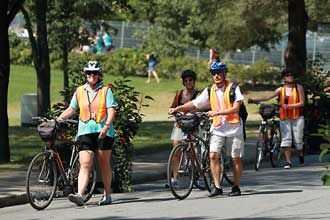
University has restricted vehicles, parking
By McGill Reporter Staff
Walk this way.
One of the biggest changes on the downtown campus this fall is something that’s missing – cars. As McGill moves to implement its Master Plan, most vehicular traffic has been prohibited from Lower Campus, almost all parking south of the Arts Building has been relocated to other areas – and cyclists are now being asked to walk their bikes once they’re inside the Roddick or Milton Gates.
“Changes like these are not implemented without the imposition of some inconvenience, but making the campus a ‘walk-bike’ zone in particular is an essential step to ensure pedestrian safety,” said Jim Nicell, Associate Vice-Principal (University Services), who noted that cyclists aren’t being asked to do anything more than others who arrive at the Gates by car or on foot and who walk the rest of the way.
As the campus becomes more pedestrian friendly, including the conversion of most of McTavish St. to a pedestrian zone, more and more people will feel increasingly free to walk all over the roadways, he said. “Having bicycles zipping through throngs of people moving from class o class is a recipe for accident and injury.
“Our success in working with the City of Montreal to get a protected bike path on University St. appears to have brought a pretty significant reduction in the number of cyclists using the campus roads to get downtown,” Nicell said. “But there are still a lot of people riding to, and through, the University. Unfortunately, a number of cyclists, a minority to be sure, feel they
have the right to ride through campus at pretty high speeds, around blind corners like that at the Macdonald Engineering Building, and past pedestrians who might not hear them coming until it’s too late.
“We want to make the campus safe for everyone, and that means cyclists – and skateboarders – are going to have to take a few extra minutes to walk,” Nicell said.
He stressed that people shouldn’t see this as McGill being “anti-bicycle.”
“We’re in the process of doubling the number of bike racks on campus. We want people to cycle to work if they can. Part of eliminating car traffic on the lower campus is aimed at encouraging the use of alternate forms of transportation – including cycling – in an effort to make an environmental difference. And the larger goal is to create a green space in the heart of the city that can be used by tens of thousands of people every day – a safe, peaceful oasis with planters and flowers, benches and tables all to be enjoyed by everyone.”
The new rules on cycling haven’t met with universal approval.
“I hate it,” said Aleks Labuda, a PhD student in Physics, who hopped off his bike at the Roddick Gates at lunchtime last Friday and started walking up the road to his Rutherford Building destination. “It used to take me 15 minutes to get to work and now it takes me 20.
“I understand, if there are a lot of people, but look –,” he said, gesturing to a main roadway with only a few scattered
pedestrians.
Elise Lepine, an International Development and Economics student, who works at an information table just inside the gates, said most cyclists are dismounting – and grumbling. If they come to talk with her, she hands them a bookmark with a website where people can find more information and some Frequently Asked Questions – www.mcgill.ca/masterplan/lowercampus/cyclists.
“I would say most people are dismounting – reluctantly,” she said. “Most aren’t too happy about it. There are people who want to find a solution that works for
everybody.”
And, she said, there have been a number of cyclists who ignore the rules and are rude to security agents who try to enforce them.
“They [the agents] have cyclists yell at them. Cyclists have spit at the guards or sometimes run directly at the guards,” she said.
Nicell acknowledges that the new rules may be frustrating for cyclists, especially when the campus is quieter.
“We’re in new territory here. Perhaps once people are accustomed to the new situation, it may be possible to explore some flexibility with specific hours when people might be permitted to cycle through the campus. It’s too early to say when or even if that could happen.
“But we know we have to put the safety of our pedestrians – most of whom are students – ahead of the fairly minor inconvenience to cyclists of having to walk a few metres.”
And when it comes to pedestrian-only McTavish St., the City of Montreal’s rules regarding pedestrian zones apply, and that means no cycling there at any time – period.
While he chafes at the new rules, Labuda acknowledges that there isn’t much alternative, especially when the campus is crowded – even if most cyclists are responsible riders who would go slowly or walk when there are people in the road.
“You can’t,” he said, “put up a sign that says ‘Jerks, please get off your bikes.’”
